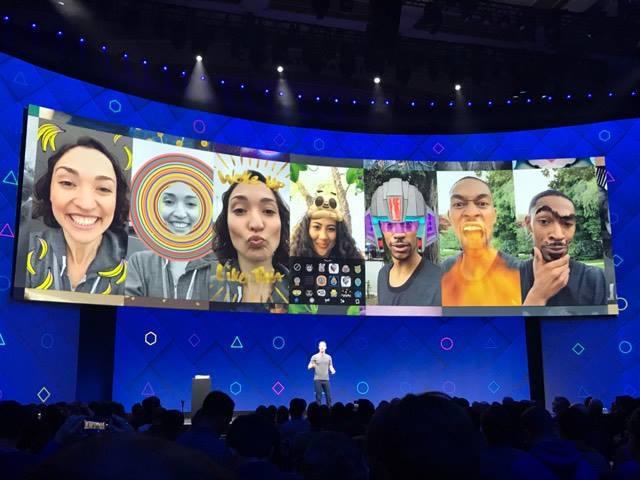Facebook Wants to Own the Future, But Marketers Can Have a Piece
Published on April 20, 2017/Last edited on April 20, 2017/7 min read


Team Braze
There were three big announcements at Facebook’s F8 conference this week. According to this marketer—you should care about one of them now, one of them soon, and one of them later. First, Facebook announced Messenger Platform 2.0, with lots of enhancements that could provide new ways of communicating with your customers and audiences. Care about that now. Second, Facebook launched a new developer platform for augmented reality (AR). Care about that soon. Third, Facebook announced a social virtual reality (VR) platform, Spaces. Care about that, you guessed it, later.
Now: Facebook Messenger Platform 2.0
The key thing to know here is Facebook is working to make Messenger more and more useful, indispensable, and consuming of user time and attention. There are several new features, and enhancements to existing features, that marketers could take advantage of. Let’s dive right in.
Discover Tab
According to Facebook, “Discover is a new section in Messenger where people can browse and find bots, nearby places and businesses to message.” App Store/Google Play :mobile apps :: Discover Tab : chatbots?
Are chatbots going to be a thing? While their presence so far has underwhelmed many, they do exist, and entire apps (some of them successful, like Digit, Lark, or Quartz) are built to function as bots. The user experience can be compelling, fun even, or they can fall totally, terribly flat—so execution is everything. Our verdict: watch this space. In the meantime, for brands who do have, or are considering building chatbots, “Discover Tab Optimization” may prove to be crucial to your user acquisition efforts.
Chat Extensions
Chat extensions enhance the ways a user can interact with a bot, by providing seamless access to social features (like payments, music, stickers). For brands with apps and bots that make logical extensions, this could be another great way to stay involved in your user’s experiences across platforms and channels.
Parametric Messenger Codes
With a name like that, it almost feels like Facebook doesn’t want you to be excited about these! No seriously, if you liked QR codes, you’ll love Parametric Messenger Codes. The idea here is you don’t need a dedicated QR reader app but can instead use the Messenger app you’re already in to get instant access to any given chatbot. Given there are 1.2 billion monthly active users on Messenger, hey this could work. If you have a bot and real world presence, this could be an experience worth testing as a way to bridge the two.
Smart Replies
Facebook is hoping to further streamline communication between brands and their customers with AI-powered Smart Replies. The bot-based service will help businesses immediately answer the frequently asked questions that appear in their inbox by scraping their Facebook pages for answers (think hours of operation, phone number, product offerings, directions, and more). Smart Replies could make it easier for brands to keep up and stay engaged with customers who want answers now and grow accustomed to chat interfaces.
More Enhancements Worth Mentioning
As often happens, some of the most impactful updates might be the least sexy on the surface. Enter the ID Matching API, which will let you connect a single user across Messenger and any of your apps or websites that use Facebook Login. This is huge if you use these services and are looking to create a single view of the customer (or at least two or three views instead of twelve or thirteen views). Of course, Facebook is working to make it as compelling as possible to build as much of your app and customer data on their platform. Every brand has to find the right balance of going where the people are, and controlling your own data. Not easy.
Additionally, bots can now access referral information when users enter via a Messenger ad in News Feed. Point for attribution. If you have a bot on your Facebook page, you can also change your primary CTAs to things like “Shop” or “Get Support” in addition to “Message Us.” This makes it easier to explain to new (or existing) audiences why your bot exists and what it can do for them. Good stuff.

Soon: Augmented Reality Camera Effects Platform
Mark Zuckerberg made it clear the AR camera platform was the key announcement to come out of F8: “We’re making the camera the first augmented reality platform.”
Are cameras the new keyword? If Snapchat is a camera company, is Facebook (via Instagram, Messenger, its flagship app, and others) a camera company AND the ultimate social network? We’ll see. What we know is Facebook is opening its camera as a platform for developers, the first AR platform of its kind. This could speed up the pace of innovation, and help ensure Facebook is a massive part of a growing number of camera/AR interactions.
For marketers, this could mean all kinds of interesting AR/camera driven enhancements down the line. Right now, though, what’s most interesting is the very clear move toward rich media in all forms of digital messaging, whether between brands and customers or friends and family. Consider the explosive growth of gifs and emojis. Before those caught on, there were images and videos, neither of which is going anywhere. All of these media formats build on each other, and become more and more available across message types as technology gets better, bandwidth cheaper, connectivity stronger. Brands who embrace these rich messages see huge benefits. The advent of Facebook’s AR camera, and the rise of stories as the new News Feed, will only continue to push forward this highly visual way that people want to communicate.
Later: Spaces – Facebook Social Virtual Reality Platform
Product Hunt says it looks like a “much friendlier version of The Matrix,” while my colleague puts it this way: “this VR thing looks like it was made for little kids.” However you look at it, Facebook previewed its new virtual reality platform, Spaces, in F8 this week. Undoubtedly there will be ways for brands to enter these experiences whether for acquisition or engagement, but that’s not happening tomorrow.
Do yourself a favor and make sure you’re mastering the basics of customer onboarding, segmentation, and engagement, so as these new platforms emerge, you’re well poised to take advantage of them based on all the great data and insights you’ve already built up through your owned channels.
Bonus: What’s It All Mean Anyway?
Regina Dugan, head of the F8 namesake Building 8, talked about the love-hate relationship we have with our phones. How magical they are, yet how they make us all kind of jerks, addicts even (Excuse me dinner companion, I’m trying to communicate with you IRL!). The vision she sets is one where Facebook is building devices and software that empower meaningful experiences and connections between people (minus the a-hole factor). Whether and when and how they get there, it’s a good goal for brands to strive for, too.
Phones have our attention, maybe more than they should. You’re fighting for some of that attention with each message you send. The best way to earn it is to provide value, and the best way to provide value is to know your audience (yes, by collecting data about them, and looking at it) and give them something they want (when they want) and you need. Brands who think this way and can figure out how to execute quickly will do well on any platform. PS: Talking with your brain and hearing with your skin?!
Releated Content
View the Blog
The new inbox reality: How iOS changes are reshaping email marketing

Aparna Prasad

Experience optimization: Turning data insights into better journeys

Team Braze

December 2025 Bonfire Marketer of the Month: Jagex’s Emma Oliver
